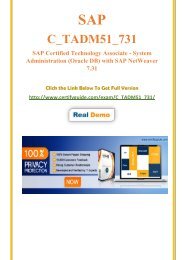CertifyGuide 300-360 Questions With Answers
You can pass your 300-360 Exam with our training kits and practice questions answers prepared by industry experts and professionals. For more info please visit here: http://www.certifyguide.com/exam/300-360/
You can pass your 300-360 Exam with our training kits and practice questions answers prepared by industry experts and professionals. For more info please visit here: http://www.certifyguide.com/exam/300-360/
You also want an ePaper? Increase the reach of your titles
YUMPU automatically turns print PDFs into web optimized ePapers that Google loves.
Cisco<br />
<strong>300</strong>-<strong>360</strong><br />
Designing Cisco Wireless Enterprise Networks<br />
(WIDESIGN)<br />
Click the Link Below To Get Full Version<br />
http://www.certifyguide.com/exam/<strong>300</strong>-<strong>360</strong> /
Question: 1<br />
Which two types of information must be included in the installation inventory portion of the postinstallation<br />
report? (Choose two.)<br />
A. all AP, controller, and MSE administrator credentials<br />
B. the names, locations, IP addresses, MAC addresses, etc. for every AP, controller, and MSE in the<br />
WLAN<br />
C. a layout of the rack that the equipment is installed<br />
D. results of the coverage audit performed with the site survey mapping tool<br />
E. the number and type of all WLAN clients and tags<br />
Answer: AB<br />
Question: 2<br />
A customer wants to implement a wireless network in a historic location, but is concerned about the<br />
structural and aesthetic impact to the facility. Which benefit of using wireless mesh addresses these<br />
concerns?<br />
A. Power is required only at the installation location.<br />
B. The APs do not have LED lights.<br />
C. More wireless channels can be supported.<br />
D. APs do not need network connections.<br />
Answer: D<br />
Question: 3<br />
An engineer is preparing for an indoor wireless LAN survey and is provisioning a survey kit. Which<br />
three pieces of equipment should be included? (Choose three.)<br />
A. external connector access point<br />
B. integrated antenna access point<br />
C. coax low-loss cable<br />
http://www.certifyguide.com/exam/<strong>300</strong>-<strong>360</strong> /<br />
Page2
D. battery operated power supply<br />
E. range finder<br />
F. Yagi antennas<br />
Answer: BDE<br />
Question: 4<br />
Which three options are benefits of U-APSD? (Choose three.)<br />
A. optimized power-save mode periods<br />
B. increased call capacity<br />
C. bandwidth reservation<br />
D. synchronization of the transmission and reception of voice frames<br />
E. efficient roaming<br />
F. priority bandwidth and polling<br />
Answer: ABD<br />
Explanation:<br />
Unscheduled automatic power-save delivery (U-APSD) is a feature that has two key benefits:<br />
The primary benefit of U-APSD is that it allows the voice client to synchronize the transmission and<br />
reception of voice frames with the AP, thereby allowing the client to go into power-save mode<br />
between the transmission/reception of each voice frame tuple. The WLAN client frame transmission<br />
in the access categories supporting U-APSD triggers the AP to send any data frames queued for that<br />
WLAN client in that AC. A U-APSD client remains listening to the AP until it receives a frame from the<br />
AP with an end-of-service period (EOSP) bit set. This tells the client that it can now go back into its<br />
power-save mode. This triggering mechanism is considered a more efficient use of client power than<br />
the regular listening for beacons method, at a period controlled by the delivery traffic indication map<br />
(DTIM) interval, because the latency and jitter requirements of voice are such that a WVoIP client<br />
would either not be in power-save mode during a call, resulting in reduced talk times, or would use a<br />
short DTIM interval, resulting in reduced standby times. The use of U-APSD allows the use of long<br />
DTIM intervals to maximize standby time without sacrificing call quality. The U-APSD feature can be<br />
applied individually across access categories, allowing U-APSD can be applied to the voice ACs in the<br />
AP, but the other ACs still use the standard power save feature.<br />
The secondary benefit of this feature is increased call capacity. The coupling of transmission<br />
buffered data frames from the AP with the triggering data frame from the WLAN client allows the<br />
frames from the AP to be sent without the accompanying interframe spacing and random backoff,<br />
thereby reducing the contention experience by call.<br />
Reference:<br />
http://www.cisco.com/c/en/us/td/docs/solutions/Enterprise/Mobility/vowlan/41dg/vowlan41dgbook/<br />
vowlan_ch2.html#wp1045982<br />
http://www.certifyguide.com/exam/<strong>300</strong>-<strong>360</strong> /<br />
Page3
Question: 5<br />
A customer has restricted the AP and antenna combinations for a design to be limited to one model<br />
integrated antenna AP for carpeted spaces and one model external antenna AP, with high gain<br />
antennas for industrial, maintenance, or storage areas. When moving between a carpeted area to an<br />
industrial area, the engineer forgets to change survey devices and surveys several APs. Which option<br />
is the best to reduce the negative impact of the design?<br />
A. Deploy the specified access points per area type.<br />
B. Resurvey and adjust the design.<br />
C. Increase the Tx power on incorrectly surveyed access points.<br />
D. Deploy unsurveyed access points to the design.<br />
Answer: B<br />
Question: 6<br />
An engineer is performing a predictive wireless design for a carpeted office space, which requires<br />
voice capability and location services. Which two requirements are inputs to the design? (Choose<br />
two.)<br />
A. overlapping -67 dBm coverage from three access points<br />
B. overlapping -75 dBm coverage from three access points<br />
C. overlapping-72 dBm coverage from two access points<br />
D. continuous -67 dBm coverage from one access pointE. continuous -72 dBm coverage from one<br />
access point<br />
Answer: A<br />
Explanation:<br />
For a voice network the APs are grouped closer together and have more overlap than a data-only<br />
installation because voice clients need to roam to a better AP before dropping packets. Generally,<br />
you should create smaller cells than for data-only networks and ensure the overlapping cell edges<br />
are at or above -67 dBm.<br />
Reference:<br />
http://www.cisco.com/c/en/us/td/docs/solutions/Enterprise/Mobility/emob73dg/emob73/<br />
ch3_WLAN.html#pgfId-1000250<br />
http://www.certifyguide.com/exam/<strong>300</strong>-<strong>360</strong> /<br />
Page4
Cisco<br />
<strong>300</strong>-<strong>360</strong><br />
Designing Cisco Wireless Enterprise Networks<br />
(WIDESIGN)<br />
Click the Link Below To Get Full Version<br />
http://www.certifyguide.com/exam/<strong>300</strong>-<strong>360</strong> /<br />
Thanks for Using Our Product<br />
We Accept<br />
http://www.certifyguide.com/exam/<strong>300</strong>-<strong>360</strong> /<br />
Page5

















